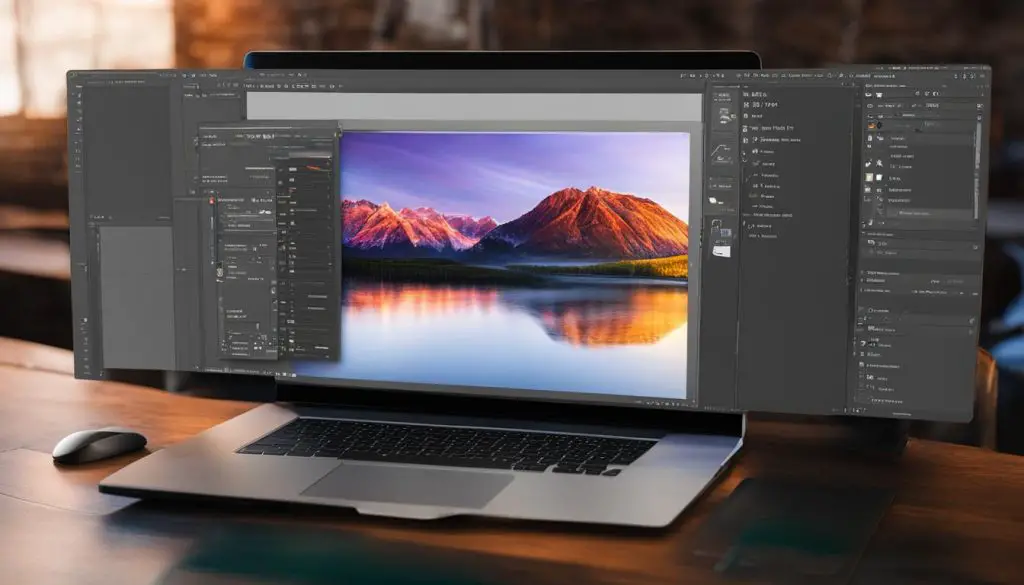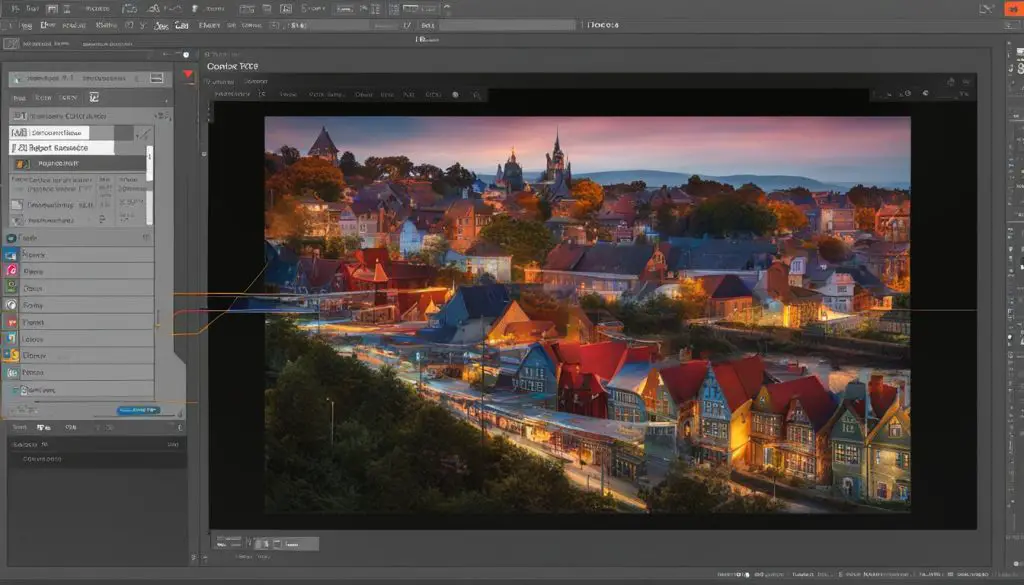Are you looking to learn how to add PSD files in Photoshop? Whether you’re a beginner or an experienced designer, understanding the process of adding PSD files can greatly enhance your workflow. In this tutorial, we will walk you through the easy steps to add, open, insert, and import PSD files in Photoshop.

Adding a PSD file in Photoshop allows you to make edits and adjustments to the original image without altering its base. By using layers, filters, and various tools, you can create stunning visual effects, manipulate colors, and apply stylistic enhancements to your projects.
Key Takeaways:
- Adobe Photoshop offers several ways to add PSD files, including opening, inserting, and importing.
- Using layers and preserving the original image are essential when working with PSD files.
- Save your work regularly to avoid losing progress and take advantage of Photoshop’s features for optimal creativity.
- Adobe Dynamic Media Classic is a platform where you can create templates from Photoshop PSD files.
- Experiment with blending modes, filters, and layer effects to enhance your PSD files.
Opening a PSD File in Photoshop
When it comes to opening a PSD file in Photoshop, there are a few simple methods you can use. First, you can launch the program and navigate to the “File” menu, then select “Open”. Alternatively, you can simply double-click the PSD file, and it will automatically open in Photoshop if it is the default program for that file type.
PSD files, which stands for Photoshop Document, can sometimes contain multiple layers and can be quite large in size. This makes them versatile for complex editing and manipulation. To work with individual layers in a PSD file, you can use the Layer menu in Photoshop. This allows you to hide or unhide specific layers, making it easier to focus on the elements you want to edit.
Remember to save your project as a PSD file once you’ve made changes. This preserves all your edits and layers, allowing you to resume editing the PSD file in Photoshop at any time. PSD files are a widely used file format in the design industry because they retain all the information and flexibility of the original project.
Example Table: Layer Management in Photoshop
| Layer | Description |
|---|---|
| Background layer | The bottommost layer in a Photoshop document. It contains the base image or color. |
| Image layers | Layers containing the main content of the design, such as photos, graphics, or text. |
| Adjustment layers | Layers that allow you to apply non-destructive edits to the image, such as adjusting brightness or contrast. |
| Text layers | Layers that contain editable text. You can change the font, size, color, and other text properties. |
| Shape layers | Layers that contain vector shapes, such as rectangles, circles, or paths. These shapes can be edited and resized without losing quality. |
Opening a PSD file in Photoshop is just the first step in working with these versatile files. Once opened, you can unleash your creativity and make the desired edits to create stunning designs. Remember to explore the various features and options in Photoshop to maximize your workflow and achieve the desired results.
Inserting a PSD File in Photoshop
To insert a PSD file in Photoshop, you have a few options that make the process quick and easy. Whether you prefer using menu commands or a simple drag-and-drop method, Photoshop offers flexibility to suit your workflow.
Method 1: Using the “File > Open” Command:
One way to insert a PSD file is by using the “File > Open” command in Photoshop. Simply navigate to the file location on your computer, select the PSD file, and click “Open.” This method is ideal if you have multiple files or want to access additional options when opening the file.
Method 2: Drag-and-Drop:
If you prefer a more intuitive approach, you can insert a PSD file by dragging and dropping it directly into an open Photoshop project. Just locate the PSD file in your file explorer, click and hold the file, then drag it into the Photoshop window. Release the mouse button to drop the file, and it will appear as a separate image or layer in your project.
Edit and Save Your Inserted PSD File:
Once you have inserted the PSD file into your Photoshop project, you can edit and make changes to it just like any other image or layer. Use the various tools and features in Photoshop to enhance the inserted file, apply adjustments, or transform it to fit your project requirements. Remember to save your project regularly to preserve all edits and inserted PSD files.

| Method | Pros | Cons |
|---|---|---|
| 1. “File > Open” Command | Easily access additional options and settings when opening the file. | Requires more steps if you have multiple PSD files to insert. |
| 2. Drag-and-Drop | Intuitive and quick method for inserting PSD files. | Limited options available during the insertion process. |
Note: The table above provides a comparison of the two methods for inserting a PSD file in Photoshop.
Importing a PSD File in Photoshop
When working in Photoshop, you have the option to import PSD files from other Adobe applications. This allows for seamless integration between different design platforms and enhances your creative possibilities. Importing a PSD file into Photoshop is a straightforward process that can be done with just a few simple steps.
Importing from Other Adobe Applications
If you have a PSD file created in applications like Illustrator, Fresco, Lightroom, or Bridge, you can easily import it into Photoshop. Simply go to the “File” menu and select the “Import” option. From there, choose the appropriate Adobe application and locate the PSD file you wish to import. Photoshop will open the file and make it available for editing within the program.
Supported File Formats
Photoshop uses plug-in modules to support various file formats, including PSD. This means you can not only import PSD files but also PDF files, which may contain both vector and bitmap data, as well as EPS files from programs like Adobe Illustrator. By supporting multiple file formats, Photoshop provides a versatile platform for designers to work with different file types and seamlessly integrate them into their projects.
Benefits of Importing PSD Files
Importing a PSD file into Photoshop opens up a world of possibilities for designers. It allows for easy collaboration between different Adobe applications, enabling designers to leverage the unique features and capabilities of each program. By importing PSD files, designers can maintain the integrity of their designs and take advantage of Photoshop’s powerful editing tools to enhance and refine their work.
Summary
Importing a PSD file in Photoshop is a simple process that widens the scope of creative projects. By seamlessly integrating files from other Adobe applications, designers can leverage the strengths of different programs and enhance their designs with Photoshop’s powerful editing tools. Whether working with PSD, PDF, or EPS files, Photoshop provides a versatile platform for designers to bring their visions to life.
Using Photoshop PSD Files in Adobe Dynamic Media Classic
Adobe Dynamic Media Classic is a powerful platform that allows users to create stunning templates from Photoshop PSD files. By leveraging the capabilities of both Photoshop and Adobe Dynamic Media Classic, designers and marketers can take their visual content to the next level. Let’s explore how to use Photoshop PSD files in Adobe Dynamic Media Classic to enhance your creative projects.

When uploading a PSD file to Adobe Dynamic Media Classic, you have the option to automatically create a template from the file. This streamlined process ensures that your PSD file is seamlessly integrated into your Adobe Dynamic Media Classic projects. With this template, you can generate multiple images where each layer becomes a separate image. This allows for greater flexibility and customization, enabling you to deliver dynamic and engaging visual experiences.
Adobe Dynamic Media Classic offers a range of options for uploading and manipulating PSD files. You can crop the PSD file, align it with color profiles, and manage layers efficiently. Additionally, Adobe Dynamic Media Classic supports up to five levels in a nested layer group for PSD files. This makes it easy to organize and structure your PSD files, ensuring a smooth workflow and optimal creative output.
Whether you’re a designer, marketer, or content creator, incorporating Photoshop PSD files into your Adobe Dynamic Media Classic projects can greatly enhance your visual storytelling capabilities. By leveraging the power of both platforms, you can create captivating templates, generate dynamic images, and elevate your creative projects to new heights.
Benefits of Using Photoshop PSD Files in Adobe Dynamic Media Classic:
- Automatically create templates from PSD files for seamless integration.
- Generate multiple images from PSD layers for greater customization.
- Crop, align with color profiles, and manage layers in Adobe Dynamic Media Classic.
- Support for nested layer groups up to five levels for organized and structured projects.
- Elevate your visual storytelling capabilities and deliver dynamic visual experiences.
Tips for Working with PSD Files in Photoshop
Working with PSD (Photoshop Document) files in Adobe Photoshop gives you the flexibility to make edits, add layers, and preserve your project with all its intricate details. To make the most of your PSD files, here are some tips and techniques to enhance your workflow.
1. Duplicate Your PSD File
Before embarking on significant edits, it’s always a good practice to create a duplicate of your PSD file. This serves as a backup, ensuring that you have a copy of the original file in case anything goes wrong during the editing process. Simply go to the “File” menu and select “Save As” to save a duplicate copy.
2. Utilize Layers for Non-Destructive Editing
One of the key advantages of PSD files is the ability to work with layers. By using layers, you can separate different elements of your design, making it easier to make non-destructive edits. Each layer can be adjusted individually, allowing you to fine-tune specific aspects of your project without affecting the rest of the design. To create a new layer, go to the “Layer” menu and choose “New” or use the shortcut “Ctrl+Shift+N”.
3. Explore Filters for Quick Adjustments
Photoshop offers a wide range of filters that can be applied to your PSD files, allowing you to instantly transform the look and feel of your design. Filters can be used to adjust colors, add special effects, or even simulate different textures. Experiment with different filters to achieve the desired stylistic adjustments. To apply a filter, go to the “Filter” menu and select the desired effect.
| Filter Name | Description |
|---|---|
| Blur | Adds blur or softness to the image. |
| Sharpen | Enhances the image’s sharpness and clarity. |
| Distort | Applies various distortions to the image, such as waves or twirls. |
| Artistic | Transforms the image into a work of art using different artistic effects. |
“Filters in Photoshop provide an easy way to make quick and dramatic adjustments to your PSD files. They can be a powerful tool in enhancing the overall impact of your design.”
By following these tips, you can optimize your workflow and unlock the full potential of working with PSD files in Adobe Photoshop. Remember to save your progress regularly and experiment with different tools and techniques to bring your creative vision to life.
Conclusion
Mastering the art of adding and working with PSD files in Photoshop is essential for any designer or photographer. With just a few easy steps, you can seamlessly integrate PSD files into your projects and leverage the full potential of Adobe Photoshop.
By following the techniques outlined in this tutorial, you can open, insert, and import PSD files with ease. Remember to save your work regularly to avoid losing any progress, and take advantage of the numerous features and options available in Photoshop to enhance your creativity and efficiency.
Whether you’re a beginner or an experienced user, Photoshop’s user-friendly interface and powerful tools make adding PSD files a breeze. Experiment with different layers, filters, and blending modes to bring your creative vision to life. With these skills in your arsenal, you’ll be able to take your designs to the next level and create stunning visuals that leave a lasting impression.
So, now that you’ve learned how to add PSD files in Photoshop, it’s time to put your knowledge into practice. Start incorporating PSD files into your projects and watch your designs come alive. With each new project, you’ll become more proficient and confident in working with PSD files, unlocking endless possibilities for your creative endeavors.
